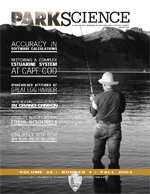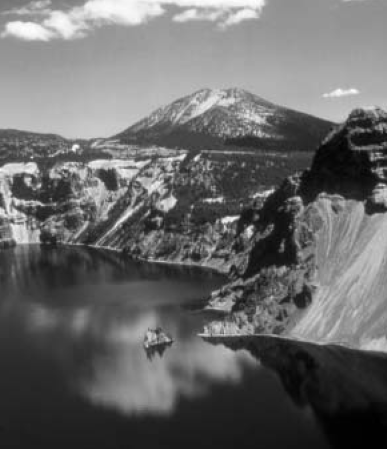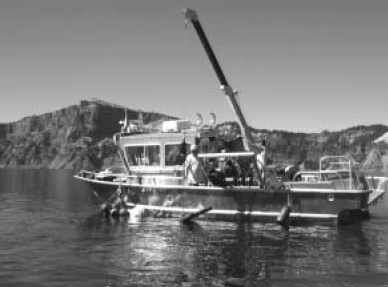By Scott F. Girdner, Crater Lake National Park
ParkScience, Vol. 22, No. 1, Fall 2003
The remarkable color and clarity of Crater Lake has dazzled visitors for generations. When the park commemorated its 100th anniversary in summer 2002, a new generation of visitors from around the world celebrated the wonders of Crater Lake for the first time. Their first view was one of surprise and amazement at the lake’s beauty and majesty. Previous generations had the same reaction when initially seeing the lake. Geologist Clarence Dutton wrote in 1886, “As the visitor reaches the brink of the cliff, he suddenly sees below him an expanse of ultramarine blue, of a richness and intensity which he has never seen before, and will not be likely to see again.” Likewise, Author Zane Grey wrote in 1919, “I expected something remarkable, but was not prepared for a scene of such wonder and beauty….Nowhere else had I ever seen such a shade of blue…. How exquisite, rare, unreal!”
Reports of early explorations of Crater Lake indicated the remarkable color and clarity resulted from a deficiency of suspended particles in the water, and unlike most lakes, few phytoplankton (microscopic plants) in the top 50 feet (15 m). Recent studies at Crater Lake by Emmanuel Boss (Oregon State University) and Bruce Hargreaves (Lehigh University), along with information collected through the park’s lake monitoring program (fig. 1), have shown just how amazing Crater Lake’s clarity is. The waters of Crater Lake are actually resetting the standards for the optical properties of “pure water” and may have the highest clarity of any lake in the world.
At the same time, this information underscores the delicate balance in the Crater Lake ecosystem and the potential for future pollution to degrade the world-renowned clarity of the lake.
Joseph Diller attempted the first measurement of the lake’s clarity in 1896 by lowering a white 10-inch-diameter dinner plate until it disappeared. Diller and other early explorers must have been amazed that the dinner plate was still visible at nearly 100 feet (30 m) deep! Since that time, investigators have taken hundreds of readings using a standard black and white Secchi disk to measure water clarity; the deepest reading, taken in June 1997, was a staggering 139 feet (42 m).
Why is Crater Lake so clear?
To appreciate the lake’s remarkable color and clarity, one must understand the relationship between ultraviolet (UV) light and the presence of dissolved organic matter in water. In most lake and ocean systems, dissolved organic matter, resulting from plants and animals within the watershed, limits the penetration of UV light. Only a very small amount of organic matter dissolved in water is needed to absorb the UV rays. Because the UV light is absorbed near the lake surface, aquatic organisms within the lake are mostly protected from the harmful UV rays. In Crater Lake, however, the natural concentration of organic matter is minimal, low enough to allow significant UV light penetration into the lake.
Crater Lake has very little dissolved organic material near the surface compared to even the clearest ocean environments: less than half the absorption of the clear waters of the Gulf of Aqaba, the Red Sea, and the Tongue of the Ocean in the Bahamas. The level of organic material in Crater Lake is so low that UV light penetrates as deep as 320 feet (100 m). A recent analysis of published UV measurements (Hargreaves 2003) indicates that in some months the surface waters of Crater Lake have greater UV transparency than any other known lake or ocean in the world! (Lake Vanda, in Antarctica, was a close second.) The results of these studies along with data collected during the park’s monitoring program indicate the top 50 feet (15 m) of Crater Lake has greater UV transparency than the values published for pure water.
Research
The effects of UV penetration on the world’s lakes and oceans are significant because of recent changes in Earth’s ozone layer, the impact of climate change on dissolved organic matter, and the corresponding fluctuations in underwater UV levels. Therefore, this research at Crater Lake is important. The work of Hargreaves and Boss will contribute to establishing new UV absorption limits for pure water and will also help in determining the ecological factors that control the underwater penetration of UV light in lake and ocean ecosystems.
We do not fully understand the direct effects of UV light penetration on the ecology of Crater Lake. Investigators speculate that a combination of limited nutrients and the deep penetration of harmful UV light influence the virtual absence of phytoplankton during most of the year in the upper 50 feet (15 m) of Crater Lake. Because of the limited phytoplankton in near-surface waters, very few particles exist to interfere with the penetration of visible light, and consequently the clarity of Crater Lake is still as clear as it was 100 years ago. The near absence of phytoplankton in surface waters also helps to explain the lake’s beautiful color, which comes from rays of sunlight that are not absorbed by particles but rather are scattered upwards into the eyes of generations of visitors. Further studies on the effects of UV light penetration and the Limnological Monitoring Program at Crater Lake will continue to assess the long-term trends to ensure preservation of this irreplaceable gem.
Reference
Hargreaves, B. R. 2003.Water column optics and penetration of UVR. Pages 59–105 in E.W. Helbling and H. E. Zagarese, editors. UV effects in aquatic organisms and ecosystems. Comprehensive series in photochemical and photobiological sciences. Royal Society of Chemistry, Cambridge, United Kingdom.
About the author
Scott F. Girdner is an Aquatic Biologist with Crater Lake National Park. He can be reached at 541-594-3078 or scott_girdner@nps.gov.
About the investigators
Bruce Hargreaves is an Associate Professor in the Earth and Environmental Sciences Department at Lehigh University, Pennsylvania. He can be contacted at 610-758-3683 or brh0@lehigh.edu.
Emmanuel Boss is an Assistant Professor in the School of Marine Sciences at the University of Maine. He can be contacted at 207-581-4378.
***previous*** — ***next***





